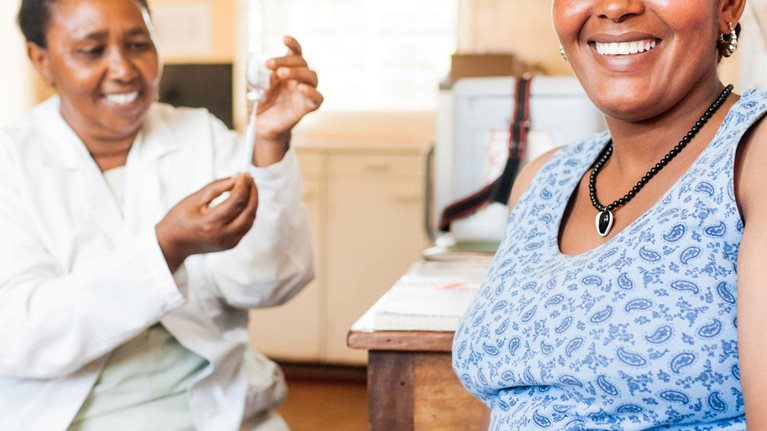What are the biggest challenges in global public health right now, and what role can pharma companies play in solving them? McKinsey’s Kenneth Bonheure sat down with Jaak Peeters, Johnson & Johnson’s head of global public health, to discuss recent advances in fighting diseases like HIV and tuberculosis globally, as well as the main obstacles to delivering real health impact to lowest-income countries.
Stay current on your favorite topics
McKinsey: From your perspective, what is the main challenge for global public health?
Jaak Peeters: Without question, it is how to accelerate impact. For this, we still need more innovative treatments. But, importantly, we also need greater collaboration between public and private sectors so that we can combine capabilities and experiences.
To be clear, there have been big successes in recent years. Take HIV infection. In the 1980s, a diagnosis meant almost certain death. Today, the life expectancy of a patient with HIV/AIDS who complies with his or her treatment is close to that of a noninfected person. Nevertheless, the target set by the Sustainable Development Goals is to end the AIDS epidemic by 2030, along with the tuberculosis (TB) epidemic, malaria, and neglected tropical diseases. Unfortunately, even if the global community maintains the current pace of progress, it won’t be enough to reach these ambitious goals. Medication had brought malaria under control, for example, but now resistance is rising, especially in Asia. Treatment resistance is also rising for TB and HIV. There are more than 19.5 million people living with HIV on antiretroviral treatment; a recent study showed that more than 10 percent of patients in 6 of the 11 countries surveyed had strains of the disease that were resistant to the most widely used medicines. We need to continue innovating and developing new treatments and combinations to stay ahead of the game.
Innovative treatment is only part of the solution, though. There are many more obstacles, such as a lack of adequate medical and clinical infrastructure in some countries, of specialized healthcare providers, and of capacity to diagnose patients and get results back quickly so that treatment can be initiated. Building strong health systems requires significant investment from governments, and it’s promising to see so much momentum behind efforts to ensure universal health coverage.
Infrastructure challenges have an enormous impact on access to medicines. Often, when we have a new product that could save lives, cure people, or prevent infections in resource-limited settings—and one that we could make affordable through equity-based tiered pricing—challenges on the delivery side prevent its rapid scale-up in country. A case in point is oncology. Even if oncology drugs were given away free, infrastructure often does not exist to deliver the care. For a lot of second- or third-line treatments, you need imaging, diagnostics, labs, oncologists—which are not always readily available in low-income countries.
All this explains why collaboration is so important. No one organization can address the world’s most pressing global public health challenges on its own. All sectors—public, private, and civil society—must sit together, with open minds, and agree on how to collaborate in the best interest of patients.
Organizations like the World Health Organization (WHO) and the United Nations can play an important role. The WHO’s new director general, Dr. Tedros Adhanom Ghebreyesus, has called for much stronger cross-sector partnerships. At the World Economic Forum in January 2018, several initiatives brought together leaders of multilateral organizations and large companies to discuss what collaboration could look like. If we can make that work through a focus on shared responsibility and accountability, I am confident we will see an impact on outcomes.
McKinsey: How does your organization operate in low-income countries to try and overcome some of the problems you describe?
Jaak Peeters: We try to build integrated delivery systems, and for this, partnerships are key. For example, Johnson & Johnson has offices and staff in dozens of countries in all regions of the world, and our people build relationships with decision makers based on mutual trust and a shared vision for improving patients’ lives. We engage in discussions with them about the interventions we could provide, the outcomes we think we could generate, and the impact these could have on their health statistics and economic metrics. At the same time, our people connect with implementing partners and local NGOs [nongovernmental organizations] that are delivering care on the ground.
Once we establish that there is interest, willingness, and trust to collaborate, and high-level agreement on an intervention—be it for multidrug-resistant TB, second-line treatment of HIV or mental healthcare—we can work with the right local partners to build an integrated solution that will ensure our medicines have impact.
For example, today we have new combinations of medicines for people living with HIV who have developed resistance to first-line treatments. But first we have to identify which patients are resistant. In many countries, diagnostic capacity is centralized in the capital city, so you can imagine what it looks like in rural areas. Blood samples have to be taken and sent to the capital city by motorcyclists who collect samples from multiple remote villages. Analyses are carried out and the results have to be taken back. That takes weeks. So we are collaborating with another company to develop a simple, point-of-care viral-load test that can be administered and read by local healthcare providers, rather than lab technicians, and is battery driven so it works in remote locations. Making point-of-care diagnostics available at affordable cost is essential to ensure the maximum impact of new treatments.
We also need to train local healthcare providers and engage and educate communities. There is a lot of stigma around many of these diseases, and you need to ensure communities understand and accept what you are doing. Only if you address all of these challenges do you have a chance to improve health outcomes. If just one element is lacking, initiatives can fail.
McKinsey: How do you foresee healthcare systems in low-income countries developing? Will they emulate those in developed countries, or evolve differently?
Jaak Peeters: They will be different on several fronts. Take the notion of integrated care. In western countries, we have had limited success trying to create integrated-care solutions because it is difficult to change long-established healthcare systems. In many low-income countries, systems are more nascent, so new and innovative solutions are both highly necessary and, most of the time, highly welcome. In some ways, you could say the modern concept of integrated care and delivery has a higher chance of success in low-income countries than in the developed world.
One of the biggest systemic challenges in low-income countries is a shortage of trained healthcare professionals. But interestingly, the use of mobile technology is helping to compensate for this. Even in the remotest areas, people now have mobile phones. We have many programs and projects going on with mobile platforms: for example, pregnant women are connected to a mobile platform where they are given advice about pregnancy, delivery, and care of newborns. These digital health solutions will have a major impact in remote places.
In countries receiving donor funding—and even in countries using domestic resources—we need to do a better job of measuring outcomes and impact relative to funding. I am certain this is one of the most important things that needs to happen in global public health—because with this data, we can demonstrate the cost-effectiveness of global health programs and show the tremendous impact the investments in health can have on sustainable development.
This is important because we cannot afford for funding for global public health to decrease, as we know that the challenges we still need to solve are, in some cases, even bigger and more complex than those we have already tackled. And we have to think about how to get greater impact from the same dollar. I believe that if we shifted to an outcomes-based funding model, you would see a major improvement in the health impact of each dollar. And once we start to see improved outcomes that are clearly linked to interventions, we can think about mobilizing more funding. We can say to the leaders of low-income countries: “Look, here are the outcomes of intervention A, B, and C. Invest in these and they will have an impact on your workforce and economy.”
Good measurement will also help us use more innovative financing approaches to mobilize investors through, say, social impact bonds, as many national governments will not be able to pay for everything. To test this model, we’ve been looking at establishing a social impact bond in a country in sub-Saharan Africa to drive progress against multidrug-resistant TB. Ensuring strong measurement is a big hurdle, and costly at first, but in the end we will see the benefits.
Better data, both at the national and subnational levels, can also show us where our gaps in access and impact are—which will become even more important as we strive to reach the last mile.

Biopharma Frontiers: What the future holds for the industry
McKinsey: What is your ambition for global public health at Johnson & Johnson five years down the road?
Jaak Peeters: In the next five to ten years, we want to contribute significantly to providing the tools to make HIV and TB history. A large-scale clinical trial of an HIV vaccine is now running in South Africa and several other countries in Southern Africa. If proven effective and approved by the necessary regulators, this would have significant impact.
In TB, we have bedaquiline, the first drug with a novel mechanism of action against TB to reach the market in more than 40 years. Bedaquiline is used in the treatment of multidrug-resistant TB as part of a combination regimen—with South Africa leading the way in uptake and access. But in multidrug-resistant patients, bedaquiline still has to be added to a regimen that takes up to 24 months and includes five or six different antibiotics. It is a significant challenge for patients to go through such a regimen. To improve on this, we have developed a portfolio of investigational TB molecules, which we hope we will be able to leverage to create a six-month, all-oral regimen that can deliver high cure rates. We have put all of the pieces in place to bring this forward, and I am hopeful we can achieve a breakthrough.
In parallel, we want to tackle latent TB. Approximately a quarter of the world’s population is infected with the latent form, and each year the infection becomes active in approximately 10 million people who go on to develop TB. Of those, 1.7 million die. We are working on a long-acting formulation of bedaquiline, which may be delivered as an injection, that we hope could stop latent TB with one dose. Of course, we can’t treat two billion people, so we need a biomarker that tells us who among the latently infected population has the highest propensity to get active TB within the next 12 months. We initially thought bedaquiline would be our one and only investment in TB—but we recognized the impact we could have in this chronically underresourced space, and now we have a full TB R&D portfolio.
Our ambition for Johnson & Johnson Global Public Health is to build on this foundation set up by bedaquiline to develop a sustainable business model to address the needs of people in low- and middle-income countries. Too often, innovations are developed with developed-country markets in mind and take years to reach people in need in developing countries. We are trying to flip this paradigm on its head by developing products to tackle some of the biggest global public health challenges—and, ultimately, ensuring that our innovations are launched in all countries and within reach of everyone, everywhere, at the same time.
Today, our Global Public Health organization sits between our commercial business and our philanthropic work—a first-of-its-kind model. Our unit’s purpose is to make new medications that can save lives, cure patients, and prevent infections available and affordable for patients in low-income countries, but in a way that is economically sustainable for our company. We have established partnerships with governments and other companies that are helping us in that endeavor, but we need more incentives in place so that we as a company can continue and scale this work—particularly on diseases like TB that have extremely limited market potential. Of course, we don’t expect our Global Public Health work to be highly profitable in the commercial sense, but reasonable revenue generation is critical to ensure that we can invest in R&D to achieve game-changing breakthroughs and increase both our reach and our impact.
I don’t know whether all of this can be achieved in five or even ten years. But this is our aim for the future—to make sure people who need life-saving or curing drugs have access now, and at the same time build a business model that is sustainable for the future.

